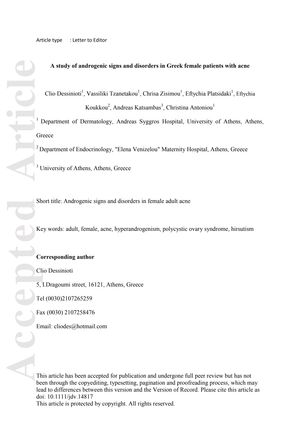TLDR Almost 40% of Greek women with acne show signs of androgen-related disorders, with adult women more likely affected.
In a cross-sectional study involving 116 Greek female patients with acne, 45 (39%) showed signs of androgenic disorders, with hirsutism being the most prevalent at 19%. Other conditions included PCOS (15%), thyroid disease (12%), androgenic alopecia (3%), and menstrual irregularities (2%). The study revealed that milder acne was more common among those with an androgenic disorder, especially in adult women aged 20 or older, where the incidence was 46% compared to 23% in adolescents. The results indicate that hyperandrogenism may be an important factor in adult female acne, suggesting that clinicians should screen for androgenic disorders in adult females presenting with acne, even in milder cases.
 12 citations
,
May 2017 in “Journal of Dermatological Treatment”
12 citations
,
May 2017 in “Journal of Dermatological Treatment” Adult acne severity is influenced by stress, skin sensitivity, makeup, stopping oral contraceptives, and requires female-specific treatment guidelines.
 46 citations
,
August 2016 in “Journal of The American Academy of Dermatology”
46 citations
,
August 2016 in “Journal of The American Academy of Dermatology” The study found that family history, personal history of adolescent acne, no pregnancies, hirsutism, office work, stress, and low intake of fruits/vegetables and fish are risk factors for adult female acne.
 20 citations
,
June 2010 in “International Journal of Dermatology”
20 citations
,
June 2010 in “International Journal of Dermatology” Women with mild acne are more likely to have polycystic ovary syndrome (PCOS) than those without acne.
 4025 citations
,
December 2003 in “Human Reproduction”
4025 citations
,
December 2003 in “Human Reproduction” The 2003 consensus updated PCOS diagnosis criteria and linked PCOS to higher risks of diabetes and heart problems, recommending lifestyle changes to lower these risks.
 1540 citations
,
October 2008 in “Fertility and Sterility”
1540 citations
,
October 2008 in “Fertility and Sterility” The report concludes that PCOS is mainly a condition of excess male hormones and its definition may change as new information is discovered.
 21 citations
,
December 2007 in “Primary Care”
21 citations
,
December 2007 in “Primary Care” Early diagnosis and treatment of PCOS is crucial to reduce emotional distress and health risks.
 12 citations
,
October 1995 in “The Journal of Clinical Endocrinology & Metabolism”
12 citations
,
October 1995 in “The Journal of Clinical Endocrinology & Metabolism” Skin changes can indicate hormonal imbalances and help diagnose endocrine disorders.
 4 citations
,
November 2016 in “Archives of Endocrinology and Metabolism”
4 citations
,
November 2016 in “Archives of Endocrinology and Metabolism” Insulin resistance is linked to larger thyroid volume in patients with polycystic ovary syndrome.
 32 citations
,
July 2001 in “Endocrine Practice”
32 citations
,
July 2001 in “Endocrine Practice” Insulin-sensitizing drugs like metformin can help with ovulation, weight loss, and lower testosterone in some women with PCOS.









